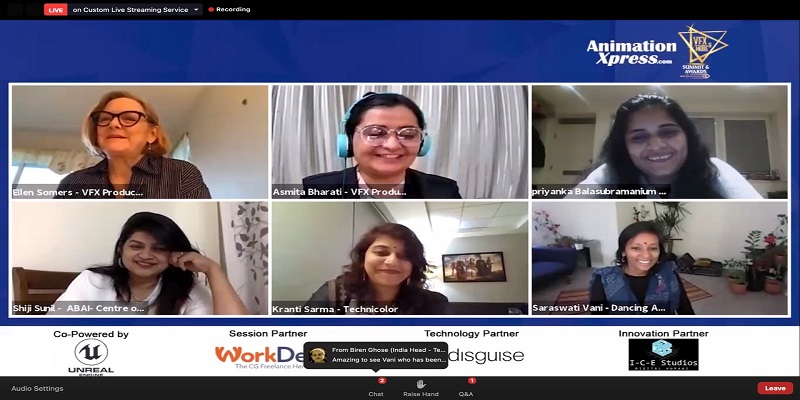
The number of female professionals employed in the global film industry is still abysmally low. But much is being done to fix this, and women are slowly pushing themselves in the direction.
According to Celluloid Ceiling: Behind-the-Scenes Employment of Women on the Top U.S. Films of 2020 report, the percentages of behind-the-scenes women working on the top 100 and 250 grossing films inched upward. 21 per cent of all directors, writers, producers, executive producers, editors, and cinematographers working on the top 100 processing films comprised of women, up from 20 per cent in 2019. By role, women accounted for 18 per cent of directors, 17 per cent of writers, 21 per cent of executive producers, 30 per cent of producers, 22 per cent of editors, and six per cent of cinematographers working on the top 250 grossing films.
The last session of Day One of VAM Summit was focused on “Women in VFX” where the speaker lineup was – Hula Hoop founder and managing director Priyanka Balasubramanian, VFX producer Ellen Somers, Technicolor India Head of Studio for Film and Episodic VFX Kranti Sarma, Dancing Atoms creator, creative producer and director Saraswathi Vani Balgam, ABAI – Centre of Excellence CEO Shiji Sunil, and the session was moderated by senior VFX producer Asmita Bharati.
The main vision of the panel was to understand why even today there are not enough women professionals practising the craft of VFX and how has the experience been for these professionals over the years. This panel threw light on the challenges, scope and affirmative actions that are needed to equalise the opportunities and ways to encourage more women to take up this profession.
Talking about the changing times, Sarma expressed, “Things have changed when compared to earlier times as the situation has moved in a positive direction for women in the VFX industry. At Technicolor, we have a workforce of over 600+ women as of today. We invest heavily in diversity and encourage women’s participation. Technicolor has a target of having a ratio of 45 per cent by 2021-22.”
Sarma believes that it is true that women started to explore the VFX industry late but slowly they are catching up with the existing workforce.
She further highlighted that though women in the industry have been moving in the right direction, they need to help themselves and participate more proactively. “We, as an organisation can only reach out to women, but it’s them who have to apply. It has to go both ways as we cannot personally convince women to join. Educational institutes show that only 30 per cent of women pass out, out of which, only a few end up to be in the VFX industry. Women need to apply more for jobs related to VFX, as the current scenario reflects that organisations seem more invested than women themselves.”
Not just that Balasubramanian has figured out the biggest challenges for women workforce to continue with their jobs in the industry is the fear of security and lack of support from their family. She said, “In 2015 when we decided to have set up in India, women preferred to be dropped at their home before six pm as their parents had issues. Some females had to quit because they were getting married and their in-laws would not let them continue. Despite all odds, the Chennai team grew from five women to 15 per cent of female employee strength in three years, proving that the situation has gotten better than it used to be.” At the same time, she agrees with the panelists that the men in their lives have always supported them in their work, be it their partners or their bosses.
Back in the day, it was difficult for an individual to create a film because of various reasons. But today, we have tons of opportunities to pick from, thanks to the digital boom. Due to technological advances, it is now possible for people to create the film they always wanted while staying home.
“It is the connection and what we believe that takes us places. Even though this a panel about women in visual effects, everything starts at home. It’s your parents who encourage you. It really depends on what kind of environment that you take in,” shared Balgam. She shared how her father told her when she was about nine-year-old that education is not for her and she should persue what’s in animation, visual effects, and films and that is where she will be.
Somers shared how her life used to be back in a time where women in the industry were very few. She shared, “It was the starting ages of the production during my time where women had to navigate what they exactly want. I have felt that for several years in the production. Today, I can see more women and it’s evolving. It is definitely changing!”
Also, the government has started to empower more women in the technical field as Sunil added that they have partnered up with the Government and international studios and institutes so that we can provide the best education in the Karnataka state. They have more than 40 per cent of women employees and there are a lot more female students who have been a part of their program.
Along with ABAI, Sunil will be running a ‘Pink batch’ which will be an all-women finishing school in animation and VFX and they will be hired by Technicolor. On that Bharati added, “Earlier there used to be finishing schools for cooking, baking and so on but today we are going to have a technical institute at this level. It is truly amazing!”
Bharati further shared how Somers trusted her, offered a project and similarly if women kept supporting one another, the industry will witness a brighter future with more women professionals in VFX!

